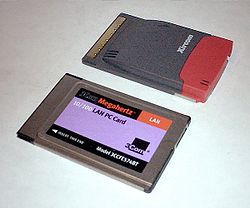From Wikipedia, the free encyclopedia
In computing, PC Card (originally PCMCIA) is the form factor of a peripheral interface designed for laptop computers. It was originally for memory expansion, but the existence of a usable general standard for notebook peripherals led to many kinds of devices being made available in this form. Typical devices include network cards, modems, and hard disks. The original use, for memory-expansion cards, is no longer common.
Many notebooks in the 1990s came with two type-II slots with no barrier in between (allowing installation of two type-II cards or one type-III card). With the removal of legacy ports, most contemporary notebooks only feature a single type-II card slot.[citation needed]
The United States computer industry created the Personal Computer Memory Card International Association to challenge the Japanese JEIDA memory card devices by offering a competing standard for memory-expansion cards. The two standards later merged as JEIDA 4.1 or PCMCIA 2.0 (PC Card) in 1991.
PCMCIA stands for Personal Computer Memory Card International Association. While this acronym did clearly describe the original intentions of the organization's standard, it was difficult to say and remember and was sometimes jokingly referred to as "People Can't Memorize Computer Industry Acronyms".[1] To aid in the widespread marketing and branding of the standard and to account for the standard's widening scope (beyond just memory cards) the association acquired the rights to the simpler term "PC Card" from IBM and began using it (rather than "PCMCIA") from version 2 of the specification onwards.
All PC Card devices use an identical 68 pin dual row connecting interface. All are 85.6 mm long and 54.0 mm wide. The form factor is also used by the Common Interface form of Conditional Access Modules for DVB broadcasts.
The original standard was defined for both 5 volt and 3.3 volt cards. The 3.3 V cards have a key on the side to protect them from being damaged by being put into a 5 V-only slot. Some cards and some slots operate at both voltages as needed. The original standard was built around an 'enhanced' 16-bit ISA bus platform.
CardBus
CardBus are PCMCIA 5.0 or later (JEIDA 4.2 or later) 32-bit PCMCIA devices, introduced in 1995 and present in laptops from late 1997 onward. CardBus is effectively a 32-bit, 33 MHz PCI bus in the PC Card form factor. CardBus includes bus mastering, which allows a controller on the bus to talk to other devices or memory without going through the CPU. Many chipsets are available for both PCI and CardBus, such as those that support Wi-Fi.
The notch on the left hand front of the device is slightly shallower on a CardBus device, so a 32-bit device cannot be plugged into a slot that can only accept 16-bit devices. Most new slots are compatible with both CardBus and the original 16-bit PC Card devices.








No comments:
Post a Comment